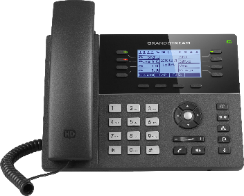Thank you for purchasing Grandstream GXP1760/GXP1760W/GXP1780/GXP1782 mid-range IP phones.
The GXP1760/GXP1760W is a mid-range IP phone with integrated dual-band Wi-Fi (For GXP1760W only), a sleek design and moderate call-volume features. It comes equipped with 6 lines, 3 SIP accounts, 6 dual-color line keys and 4 XML programmable context sensitive soft keys on a 200 x 80 pixel (3.3”) back-lit LCD display screen. For added personalization the GXP1760W features personalized ring tone/ring back tone music and integration with advanced web and enterprise applications. The GXP1760W features dual auto-sensing 10/100Mbps network ports and offers automated provisioning features with media access control. This mid-range IP phone delivers outstanding performance and design to users worldwide at a budget-friendly price point.
The GXP1780/1782 is a powerful mid-range IP phone with advanced telephony features. This mid-range IP phone comes equipped with 8 lines, 4 SIP accounts, 8 dual-color line keys and 4 XML programmable context sensitive soft keys on a 200 x 80 pixel (3.3”) back-lit LCD display screen. For added personalization the GXP1780/1782 features personalized ring tone/ring back tone music and integration with advanced web and enterprise applications. It is also one of the first Grandstream phones to come equipped with a Kensington Security Slot— one of the most popular anti-theft solutions on the market. The GXP1780/1782 supports the fastest possible connection speeds with dual auto-sensing Gigabit network ports (on GXP1782 only) as well as automated provisioning features with media access control. The GXP1780/1782 is the perfect fit for users looking for a featured-pack IP phone that delivers high performance and design at an affordable price point.
PRODUCT OVERVIEW
Feature Highlights
The following table contains the major features of the GXP1760W/GXP1780/GXP1782:
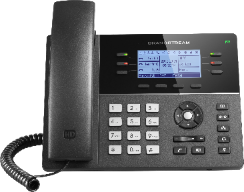 GXP1760/GXP1760W |
|
GXP1780/GXP1782 |
GXP1760/GXP1760W Technical Specifications
The following table defines all the technical specifications including the protocols / standards supported, voice codecs, telephony features, languages, and upgrade/provisioning settings for GXP1760W.
Protocols/Standards | SIP RFC3261, TCP/IP/UDP, RTP/RTCP, HTTP/HTTPS, ARP, ICMP, DNS (A record, SRV, NAPTR), DHCP, PPPoE, TELNET, TFTP, NTP, STUN, SIMPLE, LLDP, LDAP, TR-069, 802.1x, TLS, SRTP, IPv6. |
Network Interface | Dual switched auto-sensing 10/100 Mbps Ethernet ports with integrated PoE. |
Wi-Fi | Yes, integrated dual-band Wi-Fi 802.11 a/b/g/n/ac (2.4Ghz & 5Ghz). (GXP1760W only |
Graphic Display | 200×80-pixel (3.3”) backlit LCD display. |
Features Keys | 6 line keys with up to 3 SIP accounts, 4 XML programmable context sensitive Softkeys, 5 navigation/menu keys, 8 dedicated function keys for: PHONEBOOK, TRANSFER, CONFERENCE, HEADSET, MUTE, SEND/REDIAL, SPEAKERPHONE, VOLUME. |
Voice Codecs | Support for G.729A/B, G.711µ/a-law, G.726, G.722 (wide-band), G.723, iLBC, OPUS, in-band, and out-of-band DTMF (in audio, RFC2833, SIP INFO). |
Auxiliary Ports | RJ9 headset jack (allowing EHS with Plantronics headsets), USB, and a separate EHS port reserved for external EHS adapter in the future. |
Telephony Features | Hold, transfer, forward, 5-way conference, call park, call pickup, shared-call-appearance (SCA) / bridged-line-appearance (BLA), downloadable phonebook (XML, LDAP, up to 2000 items), call waiting, call log (up to 500 records), XML customization of screen, off-hook auto dial, auto answer, click-to-dial, flexible dial plan, Hot Desking, personalized music ringtones and music on hold, server redundancy and fail-over. |
HD Audio | Yes, HD handset and speakerphone with support for wideband audio. |
Base Stand | Yes, 2 angle positions available. Wall Mount stand sold separately. |
QoS | Layer 2 QoS (802.1Q, 802.1p) and Layer 3 (ToS, DiffServ, MPLS) QoS. |
Security | User and administrator level passwords, MD5 and MD5-sess based authentication, 256-bit AES encrypted configuration file, SRTP, TLS, 802.1x media access control, Kensington Security Slot (Kensington Lock) support. |
Multi-Language |
LCD Language: Arabic Czech German English Spanish French Croatian Hungarian Italian Japanese Korean Dutch Polish Portuguese Russian Turkish Traditional Chinese Simplified Chinese Hebrew |
Upgrade/Provisioning | Firmware upgrade via TFTP / HTTP / HTTPS, mass provisioning using TR-069 or AES encrypted XML configuration file. |
Power & Green Energy Efficiency | Universal power adapter included, Input: 100-240V, Output +5V, 1A. Integrated Power-over-Ethernet (802.3af). Max power consumption: 5W. |
Physical | Dimension: 231mm(W) x 167mm(L) x 86mm(H). Unit weight: 0.925kg. Package weight: 1.55kg. |
Temperature and Humidity | Operation: 0°C to 40°C. Storage: -10°C to 60°C. Humidity: 10% to 90% Non-condensing. |
Package Content | GXP1760W phone, handset with cord, base stand, universal power supply, network cable, Quick Installation Guide, GPL license. |
Compliance | FCC: Part 15 (CFR 47) Class B. CE: EN55022 Class B, EN55024 Class B, EN61000-3-2, EN61000-3-3, EN60950-1. RCM: AS/ACIF S004, AS/NZS CISPR22/24, AS/NZS 60950.1 |
GXP1780/GXP1782 Technical Specifications
The following table resumes all the technical specifications including the protocols / standards supported, voice codecs, telephony features, languages, and upgrade/provisioning settings for GXP1780/GXP1782.
Protocols/Standards | SIP RFC3261, TCP/IP/UDP, RTP/RTCP, HTTP/HTTPS, ARP, ICMP, DNS (A record, SRV, NAPTR), DHCP, PPPoE, TELNET, TFTP, NTP, STUN, SIMPLE, LLDP, LDAP, TR-069, 802.1x, TLS, SRTP, IPv6. |
Network Interface | Dual switched Ethernet ports with integrated PoE. Auto-sensing 10/100Mbps (GXP1780), 10/100/1000Mbps (GXP1782). |
Graphic Display | 200*80 pixel backlit LCD display. |
Features Keys | 8 line keys with up to 4 SIP accounts, 4 XML programmable context sensitive Softkeys, 5 navigation/menu keys, 8 dedicated function keys for: PHONEBOOK, TRANSFER, CONFERENCE, HEADSET, MUTE, SEND/REDIAL, SPEAKERPHONE, VOLUME. |
Voice Codecs | Support for G.729A/B, G.711µ/a-law, G.726, G.722(wide-band), G.723, iLBC, in-band and out-of-band DTMF (in audio, RFC2833, SIP INFO). |
Auxiliary Ports | RJ9 headset jack (allowing EHS with Plantronics headsets). |
Telephony Features | Hold, transfer, forward, 5-way conference, call park, call pickup, shared-call-appearance(SCA)/bridged-line-appearance(BLA), downloadable phonebook (XML, LDAP, up to 500 items), call waiting, call log (up to 500 records), XML customization of screen, off-hook auto dial, auto answer, click-to-dial, flexible dial plan, Hot Desking, personalized music ringtones and music on hold, server redundancy and fail-over. |
HD Audio | Yes, HD handset and speakerphone with support for wideband audio. |
Base Stand | Yes, 2 angle positions available. Wall Mount stand sold separately. |
QoS | Layer 2 QoS (802.1Q, 802.1P) and Layer 3 (ToS, DiffServ, MPLS) QoS. |
Security | User and administrator level passwords, MD5 and MD5-sess based authentication, 256-bit AES encrypted configuration file, SRTP, TLS, 802.1x media access control. |
Multi-Language |
LCD Language: Arabic Czech German English Spanish French Croatian Hungarian Italian Japanese Korean Dutch Polish Portuguese Russian Turkish Traditional Chinese Simplified Chinese Hebrew |
Upgrade/Provisioning | Firmware upgrade via TFTP / HTTP / HTTPS, mass provisioning using TR-069 or AES encrypted XML configuration file. |
Power & Green Energy Efficiency | Universal power adapter included: Input:100-240V, Output: +5V, 1A. Integrated Power-over-Ethernet (802.3af). Max power consumption: 5W. |
Physical | Dimension: 231mm(W) x 167mm(L) x 86mm(H). Unit weight: 0.925kg. Package weight: 1.55kg. |
Temperature and Humidity | Operation: 0°C to 40°C. Storage: -10°C to 60°C. Humidity: 10% to 90% Non-condensing. |
Package Content | GXP1780/GXP1782 phone, handset with cord, base stand, universal power supply, network cable, Quick Installation Guide, GPL license. |
Compliance | FCC: Part 15 (CFR 47) Class B. CE: EN55022 Class B, EN55024 Class B, EN61000-3-2, EN61000-3-3, EN60950-1. RCM: AS/ACIF S004, AS/NZS CISPR22/24, AS/NZS 60950.1 |
INSTALLATION
Equipment Packaging
The following table describe the equipment packaging:
Main Case | Yes | 1 |
Handset | Yes | 1 |
Phone Cord | Yes | 1 |
Power Adaptor | Yes | 1 |
Ethernet Cable | Yes | 1 |
Phone Stand | Yes | 1 |
Quick Installation Guide | Yes | 1 |
GXP1760/GXP1760W Package Contents
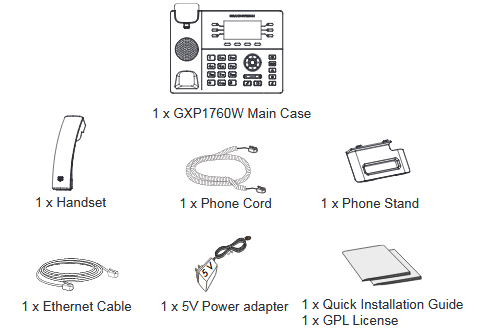
GXP1780/GXP1782 Package Contents
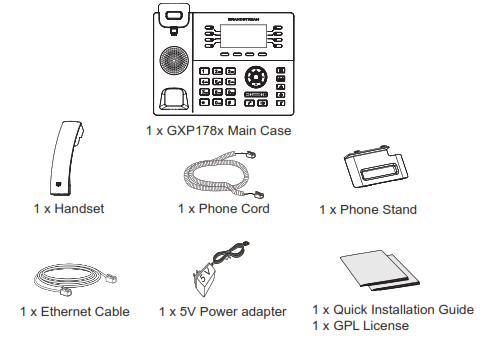
Connecting Your Phone
Handset Port | RJ9 handset connector port. |
Headset Port | RJ9 headset connector port (supporting EHS with Plantronics headset). |
LAN Port | RJ-45 port connecting to Ethernet. 10/100Mbps for GXP1760W/GXP1780 and 10/100/1000Mbps for GXP1782. |
PC Port | RJ-45 port connecting to PC. 10/100Mbps for GXP1760/GXP1760W/GXP1780 and 10/100/1000Mbps for GXP1782. |
Power Jack | 5V DC Power connector port. |
To set up the GXP1760/GXP1760W/GXP1780/GXP1782, follow the steps below:
- Attach the phone stand or wall mount to the slots on back of the phone.
- Connect the handset and main phone case with the phone cord.
- Connect the LAN port of the phone to the RJ45 socket of a hub/switch or a router (LAN side of the router) using the Ethernet cable.
- Connect the 5V DC output plug to the power jack on the phone, then plug the power adapter into an electrical outlet. If PoE switch is used in step 3, this step could be skipped.
- The LCD will display provisioning or firmware upgrade information. Please wait for the date/time display to show up before continuing.
- Use the keypad configuration menu or phone’s embedded web server (Web GUI via IP address in web browser) for further configuration on the phone.
Connecting the GXP1760W to Wi-Fi
There are two methods for connecting the GXP1760W to Wi-Fi network, through the web GUI or using the keypad menu. Please refer to the following detailed steps:
Using the WebGUI
To connect the GXP1760W to Wifi Network through the web GUI. Please refer to following steps:
- Access the web GUI using the administrator username and password.
- Navigate to Network 🡪 Wi-Fi Settings and enable the Wi-Fi.
-
Under Access Point(x) fields do the following:
- Specifies the SSID for the desired Wi-Fi network under SSID.
- Configures the Password to access the Wi-Fi network.
- Specifies the Wi-Fi encryption type under Security Type.
- Press Save and Apply button to save the Wi-Fi settings.
If the Wi-Fi settings are configured correctly, the GXP1760W will connect to the Wi-Fi network automatically and display Wi-Fi logo on the main LCD menu as displayed on the following figure.
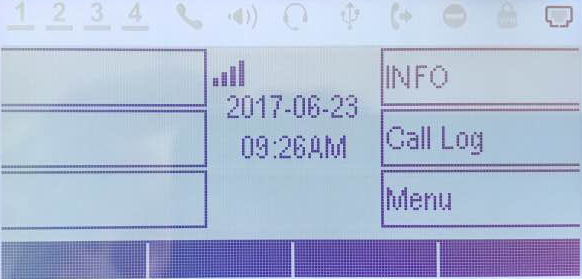
Using the Keypad Menu
To connect the GXP1760W to Wi-Fi Network through the keypad menu. Please refer to following steps:
- On LCD menu, navigate to System 🡪 Network 🡪 Wi-Fi settings and enable Wi-Fi.
- Select “Scan” and GXP1760W will automatically start scanning within the range.
- A list of Wi-Fi networks will be displayed. Select the desired network, and if required, enter the correct password to connect.
If the Wi-Fi settings are configured correctly, the GXP1760W will connect to the Wi-Fi network automatically and display Wi-Fi logo on the main LCD menu as displayed on the following figure.

GETTING STARTED
Idle Screen
GXP1760/GXP1760W/GXP1780/GXP1782 screen displays differently depending on whether the phone is idle or in use (active). The following figure shows the idle screen of GXP1780/GXP1782 as example.
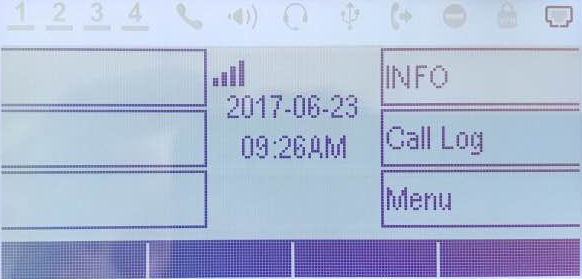
The following table describes the items displayed on GXP1760/GXP1760W/GXP1780/GXP1782 idle screen.
Date and time | Displays the current date and time. It can be synchronized with Internet time servers. |
Network icon | Shows the status of network. It will indicate whether the network is down or starting. |
Wi-Fi icon | Shows the Wi-Fi signal when the phone is connected to Wi-Fi networks. Wi-Fi icon is available on GXP1760W only. |
Status icon | Shows the status of the phone for registration status, call features and etc. using icons as shown in the next table. |
Line status indicator | Displays the name of the account that is in use. |
Softkeys in idle screen | The Softkeys are context sensitive and will change depending on the status of the phone. Typical functions assigned to Softkeys are:
Toggles between different idle screens. For example, for GXP1760W & GXP1780/82, pressing most left softkey (switch screen) will toggle among default idle screen, Virtual Multi-Purpose Keys.
Redials the last dialed number when dialed call log exists.
Unconditionally forwards the phone line (account 1) to another phone.
Shows up unanswered calls to this phone. |
Softkeys in call screen | The Softkeys are context sensitive and will change depending on the call status of the phone. Here are the main Softkeys in call screen.
Redials the last dialed number after off hook when there is existed call log.
Dials the call out after off hook and entering the number.
Answers the incoming call when the phone is ringing.
Rejects the incoming call when the phone is ringing.
Ends the active call.
Transfer softkey will show up after pressing TRAN button and entering transfer target number. Press Transfer softkey to do blind transfer.
In auto-attended transfer mode, after establishing the second call, press Split to quit transfer and go back to normal talking status.
Conferences the active calls.
Re-establish the conference among the calls on hold. |
Special Softkeys (only when device integrated with UCM6xxx) |
When the phone dials out, the CallPark softkey will display on screen. To park the call, press it to park the call on available parking lot.
During an active call, the RecOn softkey will display on screen. Press it to trigger UCM call recording.
During an active call, after RecOn softkey is pressed and call recording starts, RecOff softkey will appear on screen. Press it to stop call recording on UCM. Note: Please refer to UCM61xx User Manuals for the UCM configurations. |
| Registration Status. Solid – Registered. Hollow – Unregistered. |
| Handset Status. Off – Handset On Hook. On – Handset Off Hook. |
| Speaker Status. Off – Speaker Off. On – Speaker On. |
| Headset Status. Off – Headset Off. On – Headset On. |
| Mute Status. Off – The Active Call Is Not Muted. On – The Active Call Is Muted. |
| Call Forward Status. Off – Call Forward Feature Disabled. On – Call Forward Feature Enabled. |
| DND Status. Off – Do Not Disturb Disabled. On – Do Not Disturb Enabled. |
| SRTP Status. OFF – SRTP is not used. ON – SRTP is being used. |
| Wi-Fi Signal Status (available on GXP1760W only) OFF – Wi-Fi is Disabled. ON – Wi-Fi is Enabled. |
Using the Keypad
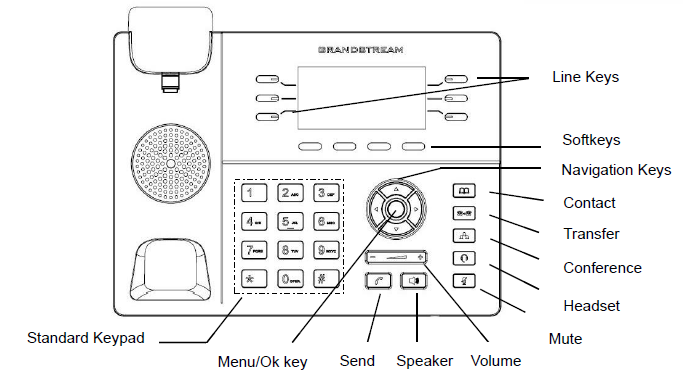
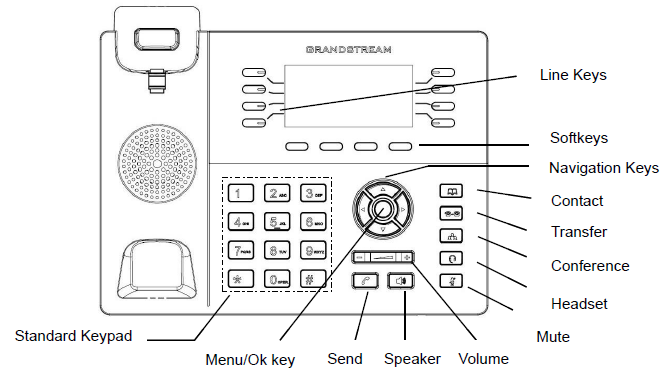
Line Key | Switch between line 1 and line 2. • Solid Green:Calling, Talking. • Flash Green:Call on hold. • Flash Red:Incoming call. |
Softkeys | The Softkeys are context sensitive and will change depending on the status of the phone. |

| Navigation Keys: When entered the menu: • Press the UP/DOWN keys to scroll through menu options. • Press the LEFT key to go back to the previous menu. • The RIGHT key has no function. In Idle: • Press the UP key to view missed calls. • Press the DOWN key to view dialed calls. • Press the RIGHT key to view answered calls. |
| Menu/OK Key: In Idle: • Press to enter the main menu. • Confirm the current selection or the inputted info. Off hook: • Switch between outgoing call and paging call. |
| Contacts: Press to view and edit contact information. |
| Mute: Press to mute or unmute the call. |
| Headset: Press to switch to headset mode. |
| Transfer: Press to transfer call. |
| Conference: Press to conference call. |
| Speaker. |
| Send/Redial. |
| Volume. |
Configuration via Keypad
To configure the LCD menu using phone’s keypad, follow the instructions below:
- Enter MENU options: When the phone is in idle, press the round MENU button to enter the configuration menu.
- Navigate in the menu options: Press the arrow keys up/down/left/right to navigate in the menu options.
- Enter/Confirm selection: Press the round MENU button or “Select” softkey to enter the selected option.
- Back: Press “Back” softkey to exit to the previous menu.
- Return to Home page: In any menu, press “Back” softkey to return to idle screen.
Note: The phone automatically exits MENU mode in these situations: An incoming call when the phone is off hook or the MENU mode if left idle for more than 60 seconds.
The MENU options are listed in the following table.
The following diagram shows the keypad MENU configuration flow:
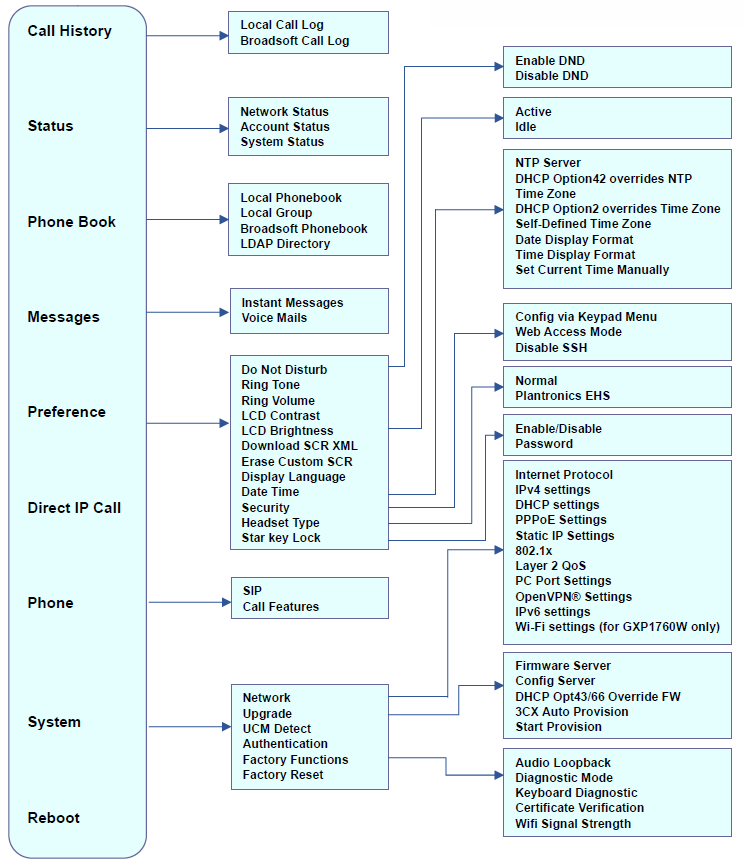
Characters Input
Each key on a GXP17xx except for key 1 corresponds to one number and a group of three letters, Users need to tap on a key multiple times until the wanted number or letter appears (Both lower and upper case available), While key 1 is used to input special characters and number 1.
Refer to below table for each key and possible character input:
| Key | Description | Key | Description | Key | Description |
|---|---|---|---|---|---|
1 | 1 Space . : / ‘ ` @ * + – = , | & ? ! % ( ) ~ _ < > { } [ ] ^ | 2 | 2 A B C a b c | 3 | 3 D E F d e f |
4 | 4 G H I g h i | 5 | 5 J K L j k l | 6 | 6 M N O m n o |
7 | 7 P Q R S p q r s | 8 | 8 T U V t u v | 9 | 9 W X Y Z w x y z |
* | * | 0 | 0 | # | # |
Making Phone Calls
Handset, Speaker and Headset Mode
The GXP1760/GXP1760W/GXP1780/GXP1782 allows users to switch among handset, speaker or headset when making calls. Press the Hook Switch to switch to handset, press the Headset button to switch to headset, or press the Speaker button
to switch to speaker.
Multiple SIP Accounts and Lines
GXP1760W can support up to 3 independent SIP accounts, GXP1780/GXP1782 can support up to 4 independent SIP accounts. Each account is capable of independent SIP server, user, and NAT settings. Each of the line buttons is “virtually” mapped to an individual SIP account. In off hook state, select an idle line and the dial tone will be heard.
To make a call, select the line you wish to use. The corresponding LINE LED will light up in green. The user can switch lines before dialing any number by pressing the LINE buttons.
To toggle between SIP accounts when the line is off-hook, keep pressing the line key until the desired account show up.
For example: If 2 independent accounts are registered on GXP1760W/GXP1780/GXP1782, when LINE 1 is pressed, the LINE 1 LED will light up in green. If LINE 2 is pressed, the LINE 2 LED will light up in green and the subsequent call will be made through SIP account 2.
Incoming calls to a specific account will attempt to use its corresponding LINE if it is not in use. When the “virtually” mapped line is in use, the phone will flash the other available LINE in red. A line is ACTIVE when it is in use and the corresponding LED is red.
Note: Regularly, to make another call under normal Line mode, users can press another line to access new call screen and initiate the outgoing calls. However, when enabling Account Mode under web GUI 🡪 Settings 🡪 Programmable Keys Settings 🡪 Call Screen Settings, a softkey “New Call” will be displayed to get another line for initiating calls on the same account with the same line key button, so lines will be grouped by account. Users can switch between lines by pressing on “Swap” softkey or navigate between lines using the up/down arrow keys.
Establishing Calls
There are several ways to make a call.
On hook dialing
Enter the number when the phone is on hook and then send out.
- When the phone is in idle, or Press Speaker button, or Press Headset button with headset plugged in, or Select an available LINE key, enter the number to be dialed out.
- The call will be dialed out.
Off hook and dial
Off hook the phone, enter the number and send out.
- Take handset off hook, or Press Speaker button, or Press Headset button with headset plugged in, or Press an available LINE key to activate speaker.
- You shall hear dial tone after off hook.
- Enter the number.
- Press SEND key or # to dial out.
Predictive dialing
While dialing, the phone will predict, and list candidates of the target number based on the entered digits. If the target number exists in the phonebook/call log, the phone will display a list of matched numbers and the user could select the number using the Up/Down key and dial out.
Redial
Redial the last dialed number.
- Take handset off hook, or Press Speaker button, or Press Headset button with headset plugged in, or Press an available LINE key to activate speaker,
- press SEND key, or the REDIAL softkey.
Automatic Redial
The phone will automatically redial the last dialed number when called number is busy.
- Go to phone’s Web GUIàSettingsà Call Features:
- Set “Enable Automatic Redial” to “yes”
- When called number is busy, the caller is prompted to “auto redial” or “cancel” on LCD.
Via Call History
Dial the number logged in phone’s call history.
- Press MENU button to bring up the main menu.
- Enter Call History, then select Local Call Log or Broadsoft Call log.
- Select the entry you would like to call using the navigation arrow keys.
- Press SEND button to dial out.
Via Phonebook
Dial the number from the phonebook.
- Press Contacts button.
- Under Contacts, enter Local Phonebook/ Broadsoft Phonebook/LDAP directory using the navigation arrow key.
- Select the contact you would like to call using the navigation arrow key.
- Press SEND button to dial the selected contact.
Speed Dial from Line Key
Dial the number configured as Speed Dial on Line Key.
- Go to phone’s Web GUIàSettingsàProgrammable Keysàvirtual Multi-Purpose Keys, configure the Line’s Key Mode as Speed Dial. Select the account to dial from, then enter the Name and User ID (the number to be dialed out) for the Line Key. Click on “Save VPK” at the bottom of the Web GUI page.
- Directly press the Speed Dial key to dial out.
Call Return
Dial the last answered call.
- Go to phone’s Web GUIàSettingsàProgrammable Keysàvirtual Multi-Purpose Keys, configure the Line’s Key Mode as Call Return. Select the account to dial from, no Name or User ID has to be set on for Call Return.
- Directly press the Call Return key to dial out.
Via Paging/Intercom
- Take handset off hook, or Press Speaker button, or Press Headset button with headset plugged in, or Press an available LINE key to activate speaker,
- You shall hear dial tone after one of the previous manipulations.
- Press MENU button to switch the call screen from “DIAL” to “PAGE”,
- Enter the number.
- Press SEND key or # to dial out.
Notes:
- After entering the number, the phone waits for the No Key Entry Timeout (Default timeout is 4 seconds, configurable via Web GUI) before dialing out. Press SEND or # key to override the No Key Entry Timeout.
- If digits have been entered after handset is off hook, the SEND key will works as SEND instead of REDIAL.
- By default, # can be used as SEND to dial the number out. Users could disable it by setting “User # as Dial Key” to “No” from Web GUIàAccount XàCall Settings.
- If the SIP Server/PBX supports Paging/Intercom and has feature codes set up already, users do not necessarily need toggle to paging mode in the call screen. Simply dial the feature code with extension as a normal call.
- When dial out via paging, user can see the “call-info” header contains “answer-after=0” and “the “alert-info” header contains “info=alert-autoanswer; delay=0” in the outgoing INVITE.
During an active call, user can see call info on LCD such as: the call lasting time, contact information if the number already be saved in phonebook. When dialing DTMF, user can press round OK button to switch to call info page.
Making Calls Using IP Addresses
Direct IP Call allows two phones to talk to each other in an ad-hoc fashion without a SIP proxy. VoIP calls can be made between two phones if:
- Both phones have public IP addresses, or
- Both phones are on the same LAN/VPN using private or public IP addresses, or
- Both phones can be connected through a router using public or private IP addresses (with necessary port forwarding or DMZ).
To make a direct IP call, please follow the steps below:
- Press MENU button to bring up main menu.
- Select “Direct IP Call” using the navigation arrow keys.
- Press MENU to enter the Direct IP Call mode.
- Input the 12-digit target IP address (Please see example below).
- Press the “More” softkey to make sure the softkey selection “IPv4” or “IPv6” is correctly selected depending on your network environment.
- Press “OK” softkey to dial.
For example:
If the target IP address is 192.168.1.60 and the port is 5062 (i.e., 192.168.1.60:5062), input the following: 192*168*1*60#5062. The * key represents the dot (.), the # key represents colon (:).
Quick IP Call Mode:
The GXP17xx also supports Quick IP Call mode. This enables the phone to make direct IP calls using only the last few digits (last octet) of the target phone’s IP address. This is possible only if both phones are under the same LAN/VPN. This simulates a PBX function using the CSMA/CD without a SIP server. Controlled static IP usage is recommended.
To enable Quick IP Call Mode, go to phone’s Web GUI🡪Settings🡪Call Features, set “Use Quick IP Call Mode” to “Yes”. Clicking on “Save and Apply” on the bottom of Web GUI page to apply the change. To make Quick IP Call, take the phone off hook first. Then dial #xxx where x is 0-9 and xxx<255. Press # or SEND and a direct IP call to aaa.bbb.ccc.XXX will be completed. “aaa.bbb.ccc” is from the local IP address regardless of subnet mask. The number #xx or #x are also valid. The leading 0 is not required (but it is OK).
For example:
- 192.168.0.2 calling 192.168.0.3 — dial #3 followed by # or “SEND”.
- 192.168.0.2 calling 192.168.0.23 — dial #23 followed by # “SEND”.
- 192.168.0.2 calling 192.168.0.123 — dial #123 followed by # “SEND”.
- 192.168.0.2: dial #3 and #03 and #003 results in the same call — call 192.168.0.3.
Notes:
- The # will represent colon “:” in direct IP call rather than SEND key as in normal phone call.
- If you have a SIP server configured, direct IP call still works. If you are using STUN, direct IP call will also use STUN.
- Configure the “User Random Port” to “No” when completing direct IP calls.
Answering Phone Calls
Receiving Calls
- Single incoming call. Phone rings with selected ring tone. The corresponding LINE key will flash in red. Answer call by taking handset off hook, or using Speaker/Headset, or pressing the flashing LINE key.
- Multiple incoming calls. When another call comes in while having an active call, the phone will produce a Call Waiting tone (stutter tone). The other LINE key will flash in red. Answer the incoming call by pressing the flashing LINE key. The current active call will be put on hold automatically.
Forward a Call (during ringing state)
When receiving an incoming call, during the ringing state the user can forward the call following one of these methods:
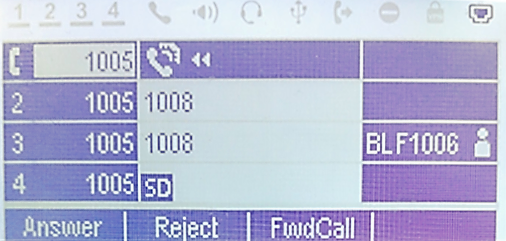
- Press the FwdCall Softkey, once the field for Forward Call number is displayed, the user enters the number to which the call will be forwarded then press OK or the Send key.
- Press the FwdCall Softkey, then press the BLF key monitoring the number to which the call will be forwarded.
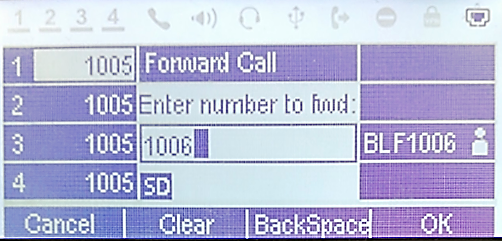
Do Not Disturb
Do Not Disturb can be enabled/disabled from phone’s LCD by following the steps below:
- Press the Menu button and select “Preference” using navigation keys.
- Select Do Not Disturb.
- Select “Enable DND” or “Disable DND”.
- Press MENU/OK key to save the changes.
When Do Not Disturb feature is turned on, the DND icon will appear on the top of the LCD. The incoming call will not be accepted or the call will directly go into voicemail.
During a Phone Call
Call Waiting/Call Hold
- Hold. Place a call on hold by pressing the HOLD Softkey. The active LINE key will blink in green.
- Resume. Resume call by pressing the blinking LINE key.
- Multiple calls. Automatically place active call on hold or switch between calls by pressing the LINE key. Call waiting tone (stutter tone) will be audible on new incoming call during the active call.
Mute
During an active call, press the MUTE button to mute/unmute the microphone. The LCD will show the Mute icon on top of the screen when the call is muted.
Call Transfer
GXP17xx Blind Transfer, Attended Transfer and Auto-Attended Transfer.
Blind Transfer
- During the first active call, press TRANSFER and dial the number to transfer to.
- Press SEND key or # to complete transfer of active call.
Attended Transfer
- During the first active call, press LINE key. The first call will be put on hold.
- Enter the number for the second call in the new line and establish the call.
- Press TRANSFER.
- Press the other LINE key which is on hold to transfer the call.
Auto-Attended Transfer
- Set “Auto-Attended Transfer” to “Yes” under Web GUI->Settings->Call Features. And then click “Save and Apply” on the bottom of the page.
- Establish one call first.
- During the call, press TRANSFER. A new line will be brought up and the first call will be automatically placed on hold.
- Dial the number and press SEND or # to make a second call. (Once the number is entered, a “Transfer” softkey will show. If “Transfer” softkey is pressed instead of SEND or #, a blind transfer will be performed).
- Press TRANSFER again. The call will be transferred.
- For Auto-Attended Transfer, after dialing out the number for the second call, a “Split” softkey will show. If the second call is not established yet (ringing), pressing “Split” will hang up the second call. If the second call is established (answered), pressing “Split” will resume the second call and keep the first call on hold.
Transfer Softkey
When Attended Transfer Mode is set to “Static”, only Blind Transfer softkey is available on LCD after the user presses TRANSFER button and enters the number for transferring call. When Attended Transfer Mode is set to “Dynamic”, both Blind Transfer and Attended Transfer softkeys are available.
5-Way Conferencing
GXP17xx can host up to 5-way conference call.
Initiate a conference call
- Establish calls with 2 or more parties, respectively.
- While 1 call is active, the other call will be put on hold with its LINE key blinking in green.
- Press CONF key.
- Press the desired LINE key on hold, the conference will be established.
- Repeat the previous 2 steps for all the other parties on hold to join the conference.
Cancel Conference
- If after pressing the CONF key, the user decides not to conference, press Cancel softkey or the current active LINE key (LED in solid green).
- This will resume the 2-way conversation with the current line.
Split and Re-conference
- During the conference, press HOLD Softkey. The conference call will be split and the calls will be put on hold separately with the LINE keys blinking in green.
- Select 1 LINE key and press to resume the 2-way conversation.
- If users would like to re-establish conference call, before 1 separate LINE is selected, press the ReConf softkey right after the conference call is held/split.
End Conference
- Users could press the EndCall softkey or simply hang up the call to terminate the conference call.
GXP1760/GXP1760W/GXP1780/GXP1782 supports Easy Conference Mode, which can be used combined with the traditional way to establish the conference.
Initiate a conference call
- Establish 1 call.
- Press CONF key and a new line will be brought up using the same account.
- Dial the number and press SEND key to establish the second call.
- Press CONF key or press the ConfCall softkey to establish the conference.
Join more parties in established conference call.
- Establish conference call.
- Press CONF key and a new line will be brought up using the same account.
- Dial the number and press SEND key to establish the second call.
- Press CONF key or press the ConfCall softkey to join the new party in the established conference.
Split and Re-conference
- During the conference, press HOLD softkey. The conference call will be split and both calls will be put on hold separately with 2 LINE keys blinking in green.
- Select 1 LINE key and press to resume the 2-way conversation.
- If users would like to re-establish conference call, before 1 separate LINE is selected, press the ReConf softkey right after the conference call is split.
Cancel Conference
- If users decide not to conference after establishing the second call, press EndCall softkey instead of the ConfCall softkey/CONF key.
- This will end the second call and the screen will show the first call on hold.
End Conference
- Users could press the EndCall softkey or simply hang up the call to terminate the conference call.
Notes:
- The party that starts the conference call has to remain in the conference for its entire duration, you can put the party on mute but it must remain in the conversation. Also, this is not applicable when the feature “Transfer on Conference Hang-up” is turned on.
- The option “Disable Conference” has to be set to “No” to establish conference.
- When using Easy Conference Mode, use SEND key to dial out the second call instead of using #, even when # could be used as SEND in normal phone calls.
Target Softkey to Select Lines During Transfer / Conference Calls
When having multiple calls on the same line, and users tried to transfer or conference the calls, a “Target” softkey will appears and when pressed, it will redirect user to the menu that show all the calls on that line. Users can simply select the account to do Transfer/Conference on for performing Blind Transfer/Conference.
Voice Messages (Message Waiting Indicator)
A blinking green MWI (Message Waiting Indicator) on the top right corner of the phone indicates a message is waiting. Meanwhile, a message box symbol will show in the front of the specific account. Dial into the voicemail box to retrieve the message by entering the voice mail number of the server or pressing the Voicemail button (Voice Mail User ID has to be properly configured as the voice mail number under Web GUI🡪Account x🡪General Settings). An IVR will prompt the user through the process of message retrieval.
Shared Call Appearance (SCA)
The GXP1760/GXP1760W/GXP1780/GXP1782 phone supports shared call appearance by Broadsoft standard. This feature allows members of the SCA group to share SIP lines and provides status monitoring (idle, active, progressing, hold) of the shared line. When there is, an incoming call designated for the SCA group, all of the members of the group will be notified of an incoming call and will be able to answer the call from the phone with the SCA extension registered.
All the users that belong to the same SCA group will be notified by visual indicator when a user seizes the line and places an outgoing call, and all the users of this group will not be able to seize the line until the line goes back to an idle state or when the call is placed on hold (with the exception of when multiple call appearances are enabled on the server side).
In the middle of the conversation, there are two types of hold: Public Hold and Private Hold. When a member of the group places the call on public hold, the other users of the SCA group will be notified of this by the red-flashing button and they will be able to resume the call from their phone by pressing the line button. However, if this call is placed on private-hold, no other member of the SCA group will be able to resume that call.
To enable shared call appearance, the user would need to register the shared line account on the phone. In addition, they would need to navigate to “Settings”🡪”Programmable Keys” on the web UI and set the line key mode as “Shared Line”. If the user requires more shared call appearances, the user can configure multiple line buttons to be “shared line” buttons associated with the account.
Call Features
The GXP1760/GXP1760W/GXP1780/GXP1782 support traditional and advanced telephony features including caller ID, caller ID with caller Name, call forward and etc.
*30 | Block Caller ID (for all subsequent calls)
|
*31 | Send Caller ID (for all subsequent calls)
|
*50 | Disable Call Waiting
|
*51 | Enable Call Waiting
|
*67 | Call with Caller ID Blocked (per call)
|
*82 | Call with Caller ID Enabled (per call)
|
*70 | Call with Call Waiting Disable (per Call)
|
*71 | Call with Call Waiting Enabled (per Call)
|
*72 | Unconditional Call Forward. To set up unconditional call forward:
|
*73 | Cancel Unconditional Call Forward. To cancel the unconditional call forward:
|
*90 | Busy Call Forward. To set up busy call forward:
|
*91 | Cancel Busy Call Forward. To cancel the busy call forward:
|
*92 | Delayed Call Forward. To set up delayed call forward:
|
*93 | Cancel Delayed Call Forward. To cancel the delayed call forward:
|
Configuring VPKs
With the new VPK feature design, line keys can be assigned with multiple functions. Users have also the ability to add more VPKs which will be displayed on different screens. The screens are dynamically added to match the extra VPKs, and incrementally indexed on the top of the main screen (1 to 4) until reaching the maximum number of supported VPKs.
Please refer to the VPK Guide for further information.
- From the web GUI
1. Access Web GUI of GXP17xx phone.
2. Go to Settings → Programmable Keys → Virtual Multi-Purpose Keys.
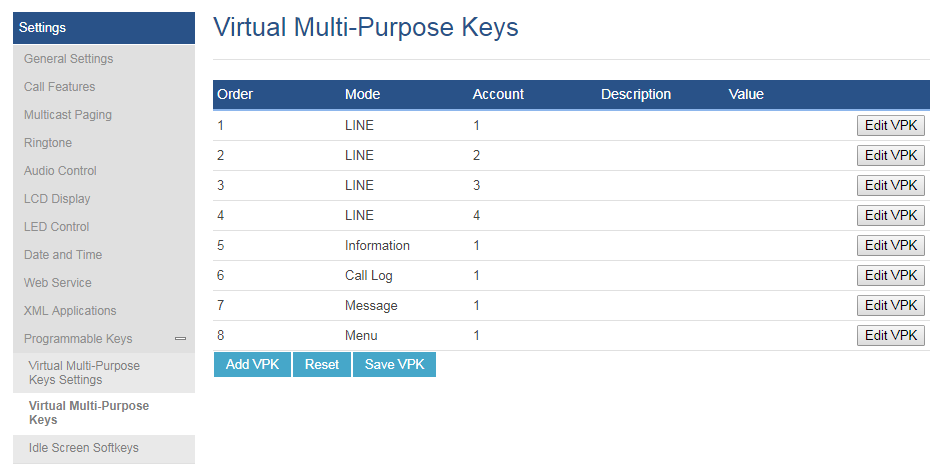
- From the phone’s keypad
Users can modify their VPK settings using device’s keypad instead of going to web GUI. Simply long press desired VPK key for 3 seconds to get into modifying mode. If users want to add a new VPK, simply long press “right” direction key for 3 seconds and phone will add a new VPK

Below screenshots example of setting a VPK as “Speed Dial” with Value “1006” from the phone’s keypad



Changing Default Password on First Boot
When accessing the GXP2130/2140/2160/2170/2135 for the first time or after factory reset, users will be asked to change the default administrator password before accessing GXP21xx Web interface.
The new password field is case sensitive with a maximum length of 25 characters. Using strong password including letters, digits and special characters is recommended for better security.
The password has to be more than 9 characters/digits and has to fulfill at least 3 options among 4 options below:
1) Numeric (0-9)
2) Capital letters (A-Z)
3) Lower case (a-z)
4) Special characters (!, @, #, $, %, ^, &, *, (, ), etc)
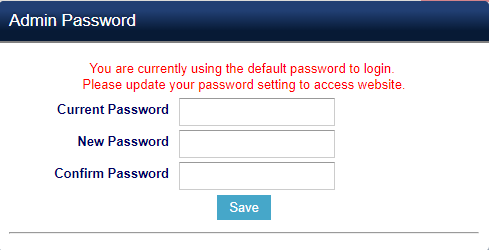
CONNECTING TO DEVICES
The GXP1760/GXP1760W/GXP1780/GXP1782 support EHS headset (Plantronics).
EHS Headset
The GXP1760/GXP1760W/GXP1780/GXP1782 supports normal RJ9 headset and Plantronics EHS headset. To use Plantronics EHS headset, go to the phone web GUI🡪Settings🡪Audio Control: Headset Type. Select “Plantronics EHS” and reboot the phone to take effect.
- Connect EHS Headset (Plantronics) to GXP1760W/GXP1780/GXP1782. Insert headset connector into the RJ11 headset port on the back of GXP1760W/GXP1780/GXP1782.
-
To use headset mode, press headset button on the GXP1760W/GXP1780/GXP1782. A headset icon
will show on the GXP1760/GXP1760W/GXP1780/GXP1782 status bar.
RESTORE FACTORY DEFAULT SETTINGS
Please follow the instructions below to reset the phone:
- Press MENU button to bring up the keypad configuration menu.
- Select “System” and enter.
- Select “Factory Reset”.
- A warning window will pop out to make sure a reset is requested and confirmed.
- Press the “Yes” softkey to confirm and the phone will reboot. To cancel the Reset, press “No” softkey instead.
CHANGE LOG
This section documents significant changes from previous versions of user guide for GXP1760W/GXP1780/GXP1782. Only major new features or major document updates are listed here. Minor updates for corrections or editing are not documented here.
Firmware Version 1.0.1.126
- No major changes.
Firmware Version 1.0.1.125
- No major changes.
Firmware Version 1.0.1.123
Firmware Version 1.0.1.119
- No major changes.
- No major changes.
- No major changes.
- No Major Changes.
- No Major Changes.
- Added Support to edit VPKs using device’s keypad [Configuring VPKs]
- No major changes.
- Added Support to BLF key as forward destination during ringing state. [Forward a Call (during ringing state)]
- Added option to auto redial when called number is busy. [Automatic Redial]
- Added Support more characters for password input from LCD: “<,>,?, {, }, [, ], ^” using key “1”.
- Added support for 3CX Auto Provision. [3CX Auto Provision]
- Added HTTP/HTTPS Username/Password fields for firmware and provisioning paths in LCD menu. [HTTP/HTTPS Server]
- Added option in LCD menu to test Wifi Signal Strength for GXP1760W. [Wi-Fi]
- Added Test Password Strength. [Test Password Strength]
- Added support for Password change upon initial login. [Change Password on first boot]
- Added Authentication section in LCD menu. [Authentication]
- Added Static/Dynamic auto-attended transfer support. [Transfer Softkey]
- This is the initial version for GXP1760W.
- Added Static/Dynamic auto-attended transfer support. [Transfer Softkey]
- Added “New Call” softkey for account mode. [New Call]
- Added “Target” softkey under account mode for transfer and conference in call screen. [Target Softkey to Select Lines During Transfer / Conference Calls]
- No major changes.
- No major changes.
- No major changes.
- This is the initial version for GXP1780/GXP1782.
